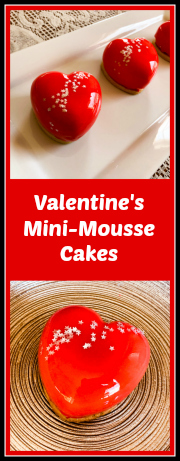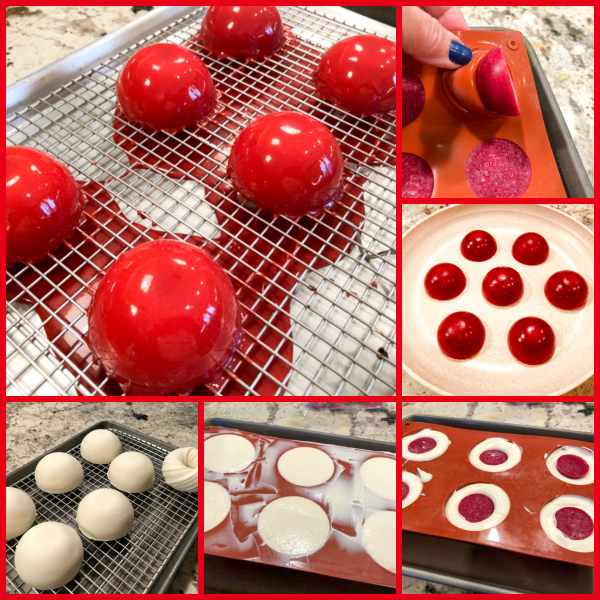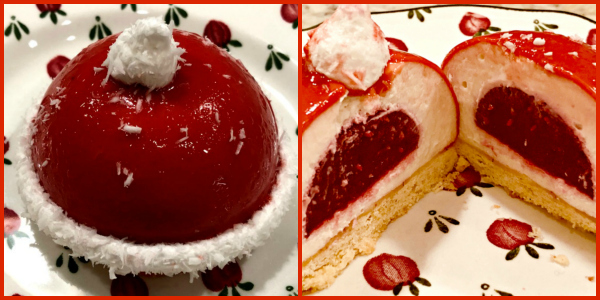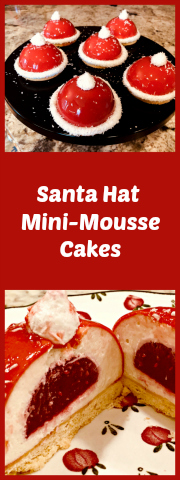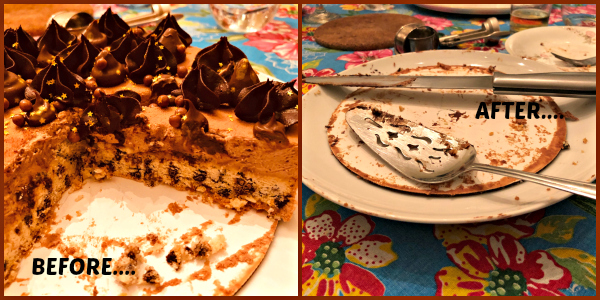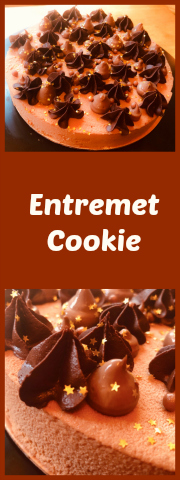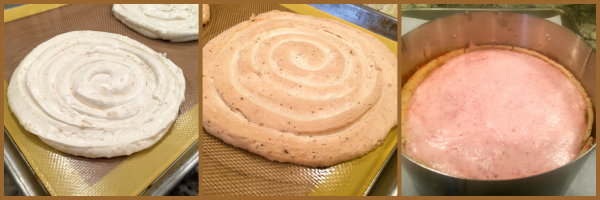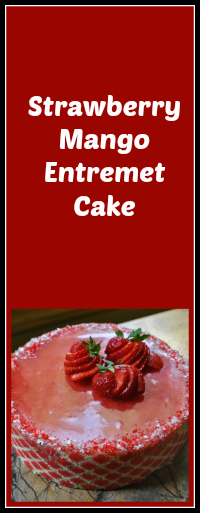
Valentine’s Day is so commercial. Who needs a special day to celebrate love and friendship? No one. We should all just ignore it. With that in mind, let me say I have no problem with a special day to shower all those special persons in your life with attention and affection. A partner, a special friend, that family member you look up to and adore. Today I share a recipe that seems a bit involved, but when you break it down into its components, it is quite simple. Trust me. I almost always speak the truth.
VALENTINE’S MINI-HEARTS MOUSSE CAKES
(inspired from many sources)
for the sable base:
120 g cold butter, cut in pieces
65 g powdered sugar
260 g all-purpose flour
30 g almond flour
pinch of salt
1 egg
Heat oven to 375 F.
Add the sugar, flour, almond flour and salt to the bowl of a KitchenAid type mixer fitted with the paddle attachment. Mix at low speed for about 30 seconds just to incorporate the ingredients together. Add the cold butter and process until the butter gets in small pieces, a bit smaller than pea-size. Add the egg and mix just until it starts to glue together as a dough, but stop before it all gets into a single mass to avoid gluten formation. Gather the dough on a piece of plastic wrap and gently form it as a disk with your hand.
Roll the pastry between plastic or parchment paper to a 3mm thickness. Cut heart or round shapes. Place over parchment paper on a baking sheet and freeze for 10 minutes. Bake for about 10 minutes until it starts to get golden around the edges. Reserve.
for the quinoa-crisp:
115 g white chocolate
20 g pistachio paste (or almond butter)
20 g puffed quinoa (or rice Krispies)
for home-made puffed quinoa, click here
Bake the puffed quinoa in a 325 F oven for 10 minutes. Meanwhile, melt the white chocolate in a microwave very gently. Mix the melted chocolate with the pistachio paste. Add the quinoa and spread in a 4 mm (1/8 inch) thickness in between two sheets of parchment paper. It will be a little sticky, try to level it as best as you can. When it is cooled down a bit, cut the exact dimension of the bigger mold you will use for the dessert. Reserve in freezer until needed.
For the Raspberry Mousse insert:
2 g of Platinum gelatin (1 sheet)
100 g mashed raspberries (fresh or frozen), seeds sieved out
20 g granulated sugar
100 g whipping cream, cold
First, put the gelatin leaves, in a bowl with very cold water to bloom for 10 minutes. In a small saucepan, heat the raspberry puree until it boils. Remove from heat, wait 5 minutes, drain the gelatin and add to the mixture. Mix until completely dissolved. Let cool to about 95 F.
Meanwhile, whip the cream to soft peaks. Gradually incorporate the cream into the raspberry mixture. Place the mousse in the semi-spheres and freeze overnight.
For the mascarpone mousse:
6 g Platinum gelatin (3 sheets)
80 ml whipping cream
55 g egg yolks
80 g granulated sugar
160 g mascarpone cheese
1/4 tsp vanilla paste
320 g heavy cream
Bloom the gelatin in cold water for 10 minutes. Combine egg yolks with sugar, whisking well and set aside. In a saucepan, heat 80 ml of cream until it boils. Remove from heat, and slowly pour a bit of the hot liquid into the egg yolk mixture, to temper it gently. Add the rest of the cream and transfer all the mixture to a saucepan.
Over low heat, cook until 180 F stirring constantly. Remove from heat, drain the gelatin, and add to the mixture, stirring until completely dissolved. Let the mixture cool down to around 140 F. Add the mascarpone cheese, mix until the cheese is incorporated. Process with a hand mixer, to emulsify. Add the vanilla paste, and let it cool to around 95 F.
Meanwhile, whip the 320 ml of cream to soft peaks. Incorporate the cream gradually to the mascarpone mixture. Place in the mini-hearts mold, 1/2 to the volume, spread gently with a spoon around the sides to avoid air bubble. Drop the frozen raspberry inserts, cover with mousse almost to the top, place the crunchy quinoa layer on top, press gently and freeze overnight.
For mirror glaze:
3 sheets Platinum grade sheet gelatin
120ml water
150 g liquid glucose
150 g granulated or caster sugar
1 tsp agar-agar
100 g condensed milk
150 g white chocolate, chopped fairly small
½ tsp titanium oxide (optional, but advisable)
red gel food coloring
Put the water, sugar, liquid glucose and agar-agar in a small pan and bring to simmering point, stirring occasionally to dissolve the sugar. Remove from the heat and let it stand for about 5 minutes. This is the base syrup for the glaze. Meanwhile, soak the gelatin in some cold water for about 5 minutes. Squeeze out the excess water and stir into the hot water, sugar and liquid glucose mixture to dissolve. Stir in the condensed milk and the titanium oxide.
Put the chocolate in a medium bowl and pour this hot mixture slowly over the chocolate, stirring gently to melt it, avoid making bubbles. Add the red food gel dye. A stick immersion blender works great, but you must keep the blades fully submerged at all times. If bubbles are present, pass the mixture through a fine sieve.
The ideal temperature to glaze is 92 to 94 F. Glaze the frozen mousse cakes, decorate with sprinkles if desired.
Defrost 2 hours in fridge before serving.
ENJOY!
to print the recipe, click here
Comments: For this dessert I used a mini-heart mold from Silikomart and a mini-half-sphere mold. The mini-heart mold I bought came with a cookie cutter with the exact dimension to made a cookie base. I am not sure every single mold sold comes with the cutter (I got mine at ebay a while ago), but any heart-shaped cookie cutter will work, if the dimensions are approximately right.
Start your preparation two days before serving, by making the raspberry centers. In this case I used a mousse, which tones down the sharpness of the raspberry a bit. If you prefer a sharper, more intense taste, consider using just the puree thickened with gelatin, like I shared in this post. You can also make the crunchy base with puffed quinoa (or rice Krispies) and the sable base two days in advance. Or even earlier. Stick the crunchy layer in the freezer, keep the sable at room temperature.
The day before serving make the mascarpone mousse and assemble the little cakes. Freeze everything and if you want to make your life very easy on serving day, prepare the mirror glaze emulsion and store it in the fridge.
On serving day, glaze those babies and keep in the fridge to defrost for a couple of hours. It is a process I love making, no matter how many times I do the mirror glaze thing, I am always in awe…
I had to add sprinkles because that’s how I roll… Also, they work wonders if you have a small boo-boo here and there on the glaze. Just drop a silver star on it, and call it a day.
You could omit the crunchy later with puffed quinoa but it is so simple to make and it does add a lot to the dessert. You can buy puffed quinoa or quickly make some, following the instructions here. If you don’t have pistachio paste, use a bit of almond butter softened in the microwave just to make it a tad more spreadable. It won’t be exactly the same, but it will work.
I am pretty happy with the way these little hearts turned out. Both mousses combined well in flavor and texture. If you don’t have the hear-shaped mold, use large half-spheres. You can also go for dessert rings and make the insert as a smaller component with any shape that is convenient for you. Just keep in mind the volumes you will need. Every component can be scaled up easily if necessary, but the raspberry mousse already makes more than you’ll need for 8 mini-cakes. I had enough for 15 inserts and only used 8. Leftovers are in the freezer, patiently waiting for a next opportunity to play.
Finally, when you pour the mirror glaze, do it over a baking sheet lined with Saran wrap, so you can easily store leftovers. They freeze well and if you accumulate several colors you can go Pollock on your next dessert…
ONE YEAR AGO: Blue Moon Milk
TWO YEARS AGO: Slow-Cooked Chicken Meatballs
THREE YEARS AGO: Zesty Flourless Chocolate Cake
FOUR YEARS AGO: Maple Pumpkin Pecan Snacking Cake
FIVE YEARS AGO: Silky Gingered Zucchini Soup
SIX YEARS AGO: Sweet Fifteen!
SEVEN YEARS AGO: Sesame and Flaxseed Sourdough
EIGHT YEARS AGO: Green Beans with Miso and Almonds
NINE YEARS AGO: Saturday Morning Scones
TEN YEARS AGO: White Bread






